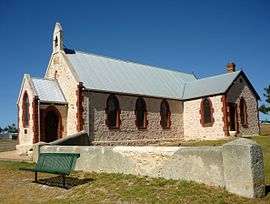Raukkan, South Australia
| Raukkan South Australia | |
|---|---|
 Raukkan Church, 2015 | |
 Raukkan | |
| Coordinates | 35°30′22″S 139°08′06″E / 35.506°S 139.135°ECoordinates: 35°30′22″S 139°08′06″E / 35.506°S 139.135°E |
| Population | 106 (2016 census)[1] |
| Location |
|
| LGA(s) | The Coorong District Council |
| State electorate(s) | MacKillop[2] |
| Federal Division(s) | Barker |
Raukkan is a small Australian Aboriginal community situated on the south-eastern shore of Lake Alexandrina in the locality of Narrung, eighty kilometres southeast of the centre of South Australia's capital, Adelaide. Raukkan is "regarded as the home and heartland of Ngarrindjeri country."[3]
History
Raukkan, which means "meeting place" in the Ngarrindjeri language,[3][4] was for thousands of years an important meeting place for Ngarrindjeri "lakalinyeri" (clans) and the location of the Grand Tendi, the parliament of the Ngarrindjeri people.[5] The Grand Tendi was composed of men elected from each of the eighteen lakalinyeri who then elected from its members the Rupulle or leader.[3]
English explorer Charles Sturt first encountered the Ngarrindjeri at Raukkan, who fed the starving Sturt and his party.[5]
In 1860 the Aborigines' Friends' Association was granted 107 hectares in the area and established a mission at Raukkan,[6] which had been named "Point McLeay" by T. B. Strangways in 1837.[7] George Taplin had selected the site, and with others such as the Rev. F. W. Cox helped build the school, church and mission station to care for the local Aboriginals, and spent the next twenty years in that service.[8] It was intended by the Aborigines' Friends' Association to help the Ngarrindjeri people, but could never be self-sufficient farming due to the poor quality of the soil in the area. Land clearing by farmers nearby also limited the ability for hunting, and other crafts and industries also met with difficulties due to changing environment and competition from nearby towns. In 1916, responsibility for Raukkan moved to South Australia's Chief Protector of Aborigines,[6] and since 1974 it has been administered by the Ngarrindjeri people themselves[9] and renamed Raukkan in 1982.[4]
Raukkan Aboriginal School is in the town.[10] In the 2016 Australian census the population was 106 persons, all of whom identified themselves as Aboriginal and Torres Strait Islander people.[1]
Voting history
In 1896, Aboriginal men and women at Raukkan were granted the vote and voted in state and federal elections (including for the first Commonwealth Parliament in 1901) and the constitutional referendums on Australian federation.[11] More than 100 Aboriginals from Raukkan were listed on the South Australian electoral roll and seventy per cent of these voted at the 1896 South Australian election.[12]
Notable residents
Raukkan was home to James Unaipon and his son David. James Unaipon was the first Australian Aboriginal deacon.[13] and co-authored writings on the Ngarrindjeri language[14] and David was a writer and inventor, who along with the Raukkan Church, is featured on the Australian fifty-dollar note.[4]
Harry Hewitt was a notable South Australian athlete who spent much of his life based at the Point McLeay mission. He would go on to play football for Medindie and Port Adelaide in a game against Fitzroy.
Roland Carter was a labourer born in Raukkan and was the first Ngarrindjeri man to enlist in the AIF from the Point McLeay Mission Station on Lake Alexandrina. He fought in World War one, was taken prisoner by the Germans and returned to live in Raukkan after being released at the end of the war. [15]
See also
References
- 1 2 Australian Bureau of Statistics (27 June 2017). "Raukkan (Indigenous Location)". 2016 Census QuickStats. Retrieved 6 January 2018.

- ↑ "District Backgrounder MacKillop". Electoral Commission of South Australia. 29 April 2014. Retrieved 11 November 2014.
- 1 2 3 Raukkan, p. 3.
- 1 2 3 Whitehorn, p. 15.
- 1 2 Mussared, D., "River people question price of 'progress', The Canberra Times, 18 January 1993, p. 3.
- 1 2 Horton, p. 930
- ↑ "To His Excellency". South Australian Gazette and Colonial Register (Adelaide, SA : 1836 - 1839). Adelaide, SA: National Library of Australia. 20 January 1838. p. 3. Retrieved 14 December 2015.
- ↑ C. E. Bartlett A Brief History of the Point McLeay Reserve and District Aborigines' Friends' Association 1959
- ↑ "Aboriginal Australians and the river : Aboriginal missions on the River Murray". State Library of South Australia. Retrieved 11 November 2014.
- ↑ "Raukkan Aboriginal School". Department for Education and Child Development, Government of South Australia. Retrieved 11 November 2014.
- ↑ "History of the Indigenous vote". Indigenous Australians. Australian Electoral Commission. Retrieved 1 April 2014.
- ↑ Lawrence, Kay. "Weaving the Murray". Challenging Craft. Gray's School of Art, Aberdeen. Missing or empty
|url=(help);|access-date=requires|url=(help) - ↑ "David and James Unaipon - Ngarrindjeri Educators". The Unaipon School, UniSA. Missing or empty
|url=(help);|access-date=requires|url=(help) - ↑ Gale, p. 71.
- ↑ "Wartime magazine issue 76 | The Australian War Memorial". www.awm.gov.au. Retrieved 2018-03-19.
Sources
- Gale, M. (1997) Dhanum Djorra'wuy Dhawu, Aboriginal Research Institute, Underdale. ISBN 0-86803-182-8.
- Horton, D. (1994) The Encyclopaedia of Aboriginal Australia : Aboriginal and Torres Strait Islander history, society and culture; Vol. 2 M-Z, Australian Institute of Aboriginal and Torres Strait Islander Studies: Canberra. ISBN 0855752505.
- Jenkin, G. (1979) Conquest of the Ngarrindjeri, Rigby: Adelaide. ISBN 0-7270-1112-X.
- Raukkan Community Council (2009) Historic Raukkan, Home of the Ngarrindjeri, Raukkan Community Council: Raukkan.
- Whitehorn, Zane "Raukkan community: Pride of the Ngarrindjeri nation", Indigenous Newslines, March–May 2010.